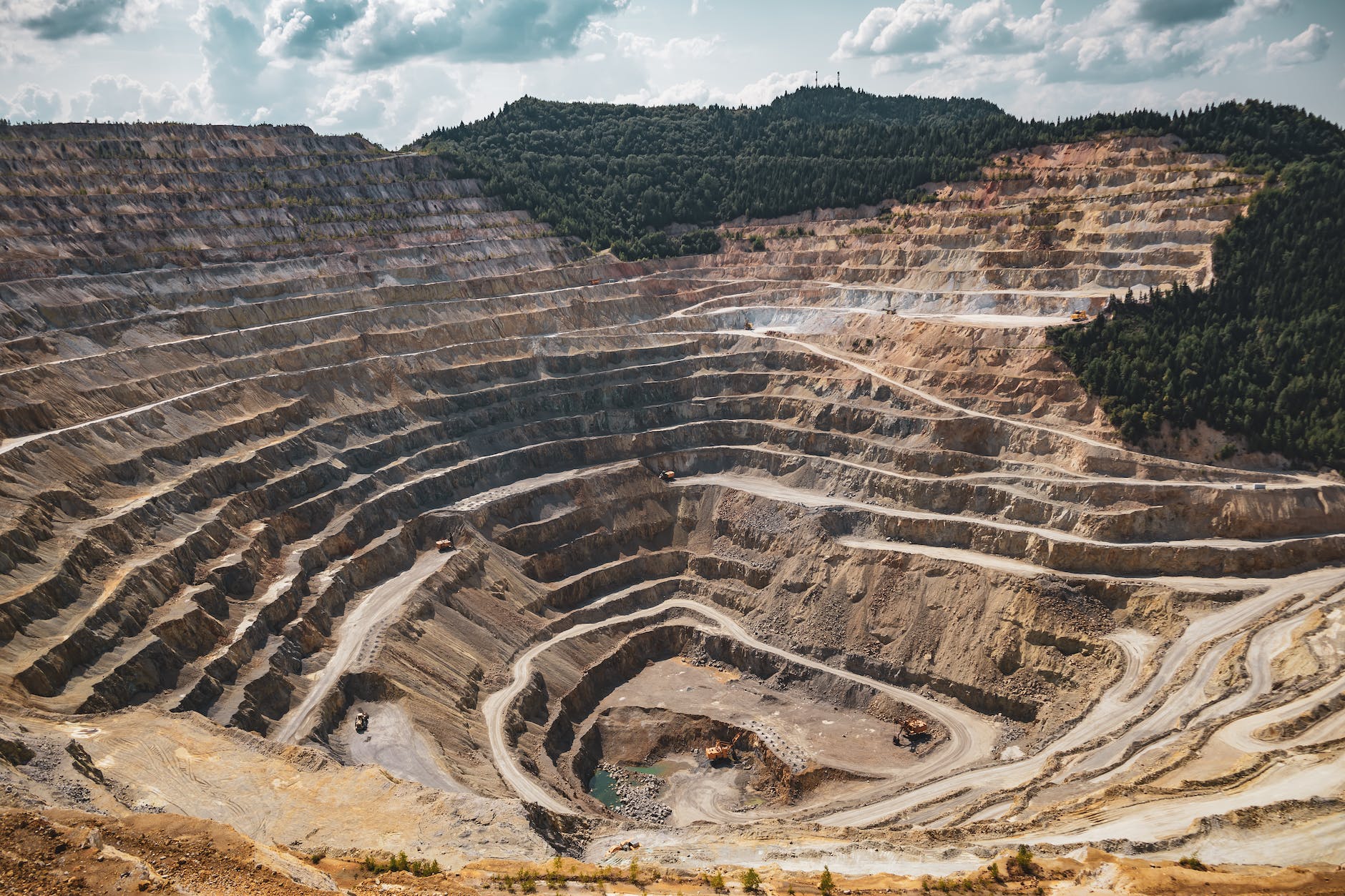
Presentation
Strip mining, otherwise called surface mining or open-pit mining, is a technique used to extricate minerals and metals that are close to the outer layer of the earth. This method includes the expulsion of huge areas of soil and rock to get to the significant materials below. While strip mining is a productive and financially savvy strategy for separating assets, it has critical natural and social effects. This article investigates the course of strip mining, its advantages and disadvantages, and the endeavors being made to alleviate its antagonistic impacts.
The Course of Strip Mining
Strip mining includes a few stages, each urgent to the productive extraction of assets.
Site Arrangement
Prior to mining starting, the chosen site goes through a broad arrangement. This incorporates directing natural effect appraisals, getting grants, and clearing vegetation and dirt. The dirt is frequently put away for later use in land recovery.
Expulsion of Overburden
The following stage includes eliminating the overburden, which is the layer of soil and rock covering the mineral store. Large equipment, for example, draglines, tractors, and earthmovers, is utilized to strip away this material. Now and again, explosives are utilized to separate huge rocks.
Extraction of Minerals
When the overburden is taken out, the uncovered mineral store is extricated. This can include penetrating, impacting, and moving the mineral to handling offices. The strategy for extraction relies on the kind of mineral and the topography of the site.
Recovery
After the minerals have been extricated, endeavors are made to reestablish the land in a unique state or in a condition that can uphold new purposes. This cycle, known as recovery, includes supplanting the overburden, recontouring the land, supplanting dirt, and replanting vegetation.
Kinds of Strip Mining
There are a few kinds of strip mining, each tailored to explicit sorts of stores and land conditions.
Region Strip Mining
Region strip digging is usually utilized for extricating coal and different minerals that are spread over huge, level regions. In this strategy, huge rectangular portions of land are eliminated in turn. The overburden from each strip is set in the nearby strip where mining has been finished.
Shape Strip Mining
Shape-strip mining is utilized in bumpy or rugged landscapes. The mining follows the shape of the land, making porches or seats. This strategy limits how much overburden should be taken out and decreases the risk of avalanches.
Mountain Ridge Expulsion
Mountain ridge evacuation is a dubious type of strip mining where the highest points of mountains are eliminated to get to coal creases. This technique includes broad impacting and can bring about critical scene changes and ecological harm.
Natural Effects
While strip mining is a viable strategy for extricating assets, it has significant ecological effects.
Living Space Annihilation
One of the most prompt effects of strip mining is the annihilation of environments. The expulsion of vegetation and dirt disturbs environments and dislodges natural life. This can prompt a loss of biodiversity and changes in nearby environments.
Soil Disintegration
The expulsion of overburden and vegetation expands the risk of soil disintegration. Without plants to moor the dirt, wind and water can divert the free material, prompting the development of gorges and the deficiency of fruitful dirt.
Water Contamination
Strip mining can likewise prompt water contamination. The interaction can uncover sulfide minerals, which can react with water and air to form sulfuric corrosives. This corrosive can filter into adjacent streams, prompting corrosive mine seepage, which can hurt oceanic life and sully drinking water supplies.
Air Contamination
The residue and particulate matter produced during strip mining can contribute to air contamination. This can affect nearby networks, including respiratory issues and different diseases.
Monetary and Social Effects
Strip mining has both positive and negative monetary and social effects.
Work Creation
One of the essential advantages of strip mining is job creation. The mining business gives potential open doors to many individuals, especially in rustic regions where other open positions might be restricted.
Neighborhood Economies
Strip mining can likewise add to neighborhood economies. The extraction and handling of minerals create income, which can be utilized to finance foundation tasks and local area administrations.
Local area dislodging
Nonetheless, strip mining can likewise prompt the uprooting of networks. The requirement for huge parcels of land can bring about the migration of inhabitants, frequently prompting social interruption and loss of local area attachment.
Relief and Guidelines
Endeavors are being made to moderate the ecological and social effects of strip mining through better guidelines and recovery rehearsals.
Regulation
Numerous nations have ordered regulations to control strip mining and limit its ecological effects. These regulations frequently require mining organizations to have lead natural effect appraisals, secure permits, and comply with severe recovery necessities.
Recovery Practices
Propels in recovery rehearsals are assisting with reestablishing mined land to a more normal state. Strategies, for example, recontouring the land, supplanting dirt, and replanting local vegetation, are being utilized to restore mined regions.
Supportable Mining Practices
The mining business is likewise investigating more economical practices. This includes lessening the amount of overburden eliminated, limiting the utilization of perilous synthetic substances, and further developing waste administration rehearsals.
Contextual investigations
Appalachian Mountains, USA
The Appalachian Mountains in the eastern US have been essentially affected by strip mining, especially peak evacuation. This strategy has prompted the annihilation of woodlands, the change of streams, and the loss of biodiversity. Be that as it may, endeavors are being made to restore the land and reestablish environments through broad recovery projects.
Tar Sands, Canada
In Alberta, Canada, strip mining is utilized to extract oil from tar sands. This cycle has prompted the obliteration of boreal woodlands and wetlands, as well as the contamination of waterways and lakes. Recovery endeavors are in progress, yet the size of the aggravation makes rebuilding testing.
Future Headings
The fate of strip mining will probably include a blend of further developed innovations, stricter guidelines, and a more prominent emphasis on supportability.
Mechanical Developments
Mechanical headways are making it conceivable to separate minerals all the more proficiently and with less natural effect. For instance, accuracy mining procedures and robotization can lessen the amount of overburden eliminated and limit unsettling influences on the scene.
Sustainable power
As the world moves towards sustainable power sources, the interest in specific minerals utilized in clean energy advancements is expanding. This might prompt an ascent in strip mining exercises, yet it likewise presents a chance to foster more reasonable mining rehearsals.
Local Area Commitment
Connecting with neighborhood networks in the preparation and execution of strip mining projects is critical. This incorporates getting assent, giving fair pay, and including networks in recovery endeavors.
End
Strip mining is an important, but dubious, strategy for removing significant minerals and metals. While it gives monetary advantages and is fundamental for specific ventures, its natural and social effects can’t be disregarded. Through better guidelines, imaginative innovations, and a pledge to manageable practices, it is feasible to relieve the unfavorable impacts of strip mining and guarantee that mined land can be restored sometime later. The harmony between asset extraction and ecological stewardship will be critical to the fate of strip mining.



